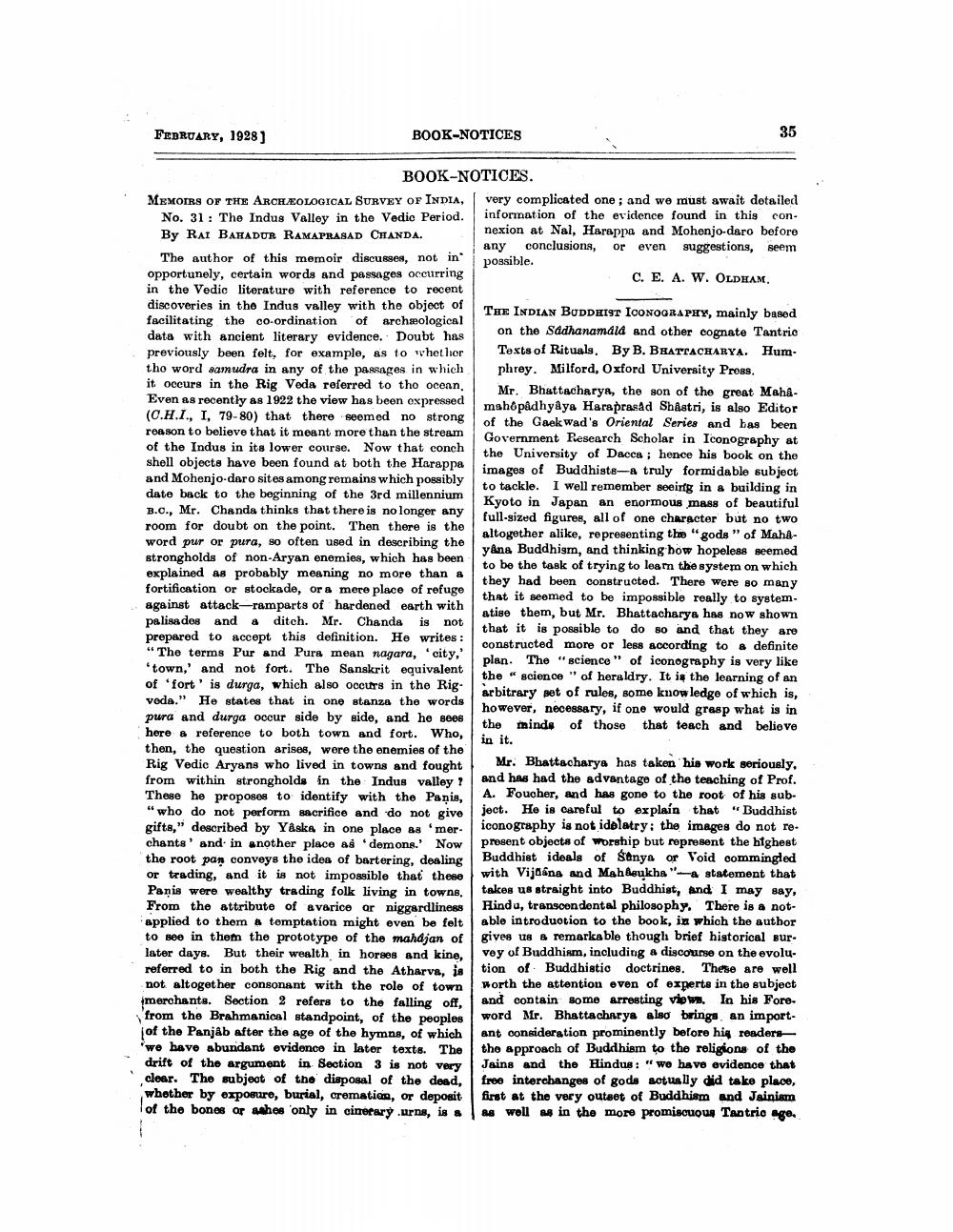________________
FEDRUARY, 1928)
BOOK-NOTICES
BOOK-NOTICES. MEMOIRS OF THE ARCHEOLOGICAL SURVEY OF INDIA, very complicated one ; and we must await detailed
No. 31: The Indus Valley in the Vedic Period. information of the evidence found in this con. By RAI BAHADUR RAMAPRASAD CHANDA.
nexion at Nal, Harappa and Mohenjo-daro before
any conclusions, or even suggestions, seem The author of this memoir discusses, not in
possible. opportunely, certain words and passages occurring
C. E. A. W. OLDHAM. in the Vedic literature with reference to recent discoveries in the Indus valley with the object of
THE INDIAN BUDDHIST ICONOGRAPHY, mainly based facilitating the co-ordination of archeological
on the Sadhanamala and other cognate Tantric data with ancient literary evidence. Doubt has previously been felt, for example, as to whether Texts of Rituals. By B. BHATTACHARYA. Hum. tho word samudra in any of the passages in which phrey. Milford, Oxford University Press. it occurs in the Rig Veda referred to tho ocenn.
Mr. Bhattacharya, the son of the great MahaEven as recently as 1922 the view has been oxpressed
mshopadhyaya Haraprasad Shastri, is also Editor (C.H.I., I, 79-80) that there seemed no strong
of the Gaek wad's Oriental Series and has been roason to believe that it meant more than the stream
Government Research Scholar in Iconography at of the Indus in its lower course. Now that conch
the University of Dacca ; hence his book on the shell objects have been found at both the Harappa
images of Buddhists-a truly formidable subject and Mohenjo-daro sites among remains which possibly
to tackle. I well remember seeing in a building in date back to the beginning of the 3rd millennium
Kyoto in Japan an enormous mass of beautiful B.O., Mr. Chanda thinks that there is no longer any
full-sized figures, all of one character but no two room for doubt on the point. Then there is the
altogether alike, representing the "gods" of Mahlword pur or pura, so often used in describing the
yAna Buddhism, and thinking bow hopeless seemed strongholds of non-Aryan enemies, which has been
to be the task of trying to learn the system on which explained as probably meaning no more than a
they had been constructed. There were so many fortification or stockade, or a more place of refuge
that it seemed to be impossible really to systemagainst attack-ramparts of hardened earth with
atise them, but Mr. Bhattacharya has now shown palisades and a ditch. Mr. Chanda is not
that it is possible to do so and that they are prepared to accept this definition. He writes :
constructed more or less according to & definite “The terms Pur and Pura mean nagara,"city,'
plan. The "science" of iconography is very like 'town,' and not fort. The Sanskrit equivalent
the " science " of heraldry. It is the learning of an of 'fort' is durga, which also occurs in the Rig.
arbitrary set of rules, some knowledge of which is, voda." He states that in one stanza the words
however, necessary, if one would grasp what is in pura and durga occur side by side, and he sees
the minds of those that teach and beliove here a reference to both town and fort. Who,
in it. then, the question arises, were the enemies of the Rig Vedic Aryans who lived in towns and fought Mr. Bhattacharya has taken his work seriously. from within strongholds in the Indus valley and has had the advantage of the teaching of Prof. These he proposes to identify with the Panis,
A. Foucher, and has gone to the root of his sub" who do not perform sacrifice and do not give
ject. He is careful to explain that "Buddhist gifts," described by Yåske in one place sa 'mer
iconography is not idolatry: the images do not rechants' and in another place as demons. Now present objects of Worship but represent the highest the root pan conveys the idea of bartering, dealing Buddhist ideals of Stnya or Void commingled or trading, and it is not impossible that these
with Vijana and Mahkeukha"-a statement that Panis were wealthy trading folk living in towns.
takes us straight into Buddhist, and I may say, From the attribute of a varice or niggardliness
Hindu, transcendental philosophy. There is a notapplied to them & temptation might even be felt able introduotion to the book, in which the author to see in them the prototype of the mahajan of gives us & remarkable though brief historical sur. Inter days. But their wealth in horses and kine. Ivey of Buddhism, including discounse on the evolu. referred to in both the Rig and the Atharve, istion of Buddhistic doctrines. These are well not altogether consonant with the role of town worth the attention even of experts in the subject merchants. Section 2 refers to the falling off,
and contain some arresting view. In his Fore. from the Brahmanical standpoint, of the peoples
word Mr. Bhattacharya also brings an importof the Panjab after the age of the hymns, of which
ant consideration prominently belore hig readers we have abundant evidence in later texts. The the approach of Buddhism to the religions of the drift of the argument in Section 3 is not very
Jains and the Hindus: "We have evidence that clear. The subject of the disposal of the dead, free interchanges of gods actually did take place, whother by exposure, burial, cremation, or deposit first at the very outset of Buddhism and Jainism of the bones or whes only in cinerary.urns, isa as well as in the more promiscuous Tantrio age.




